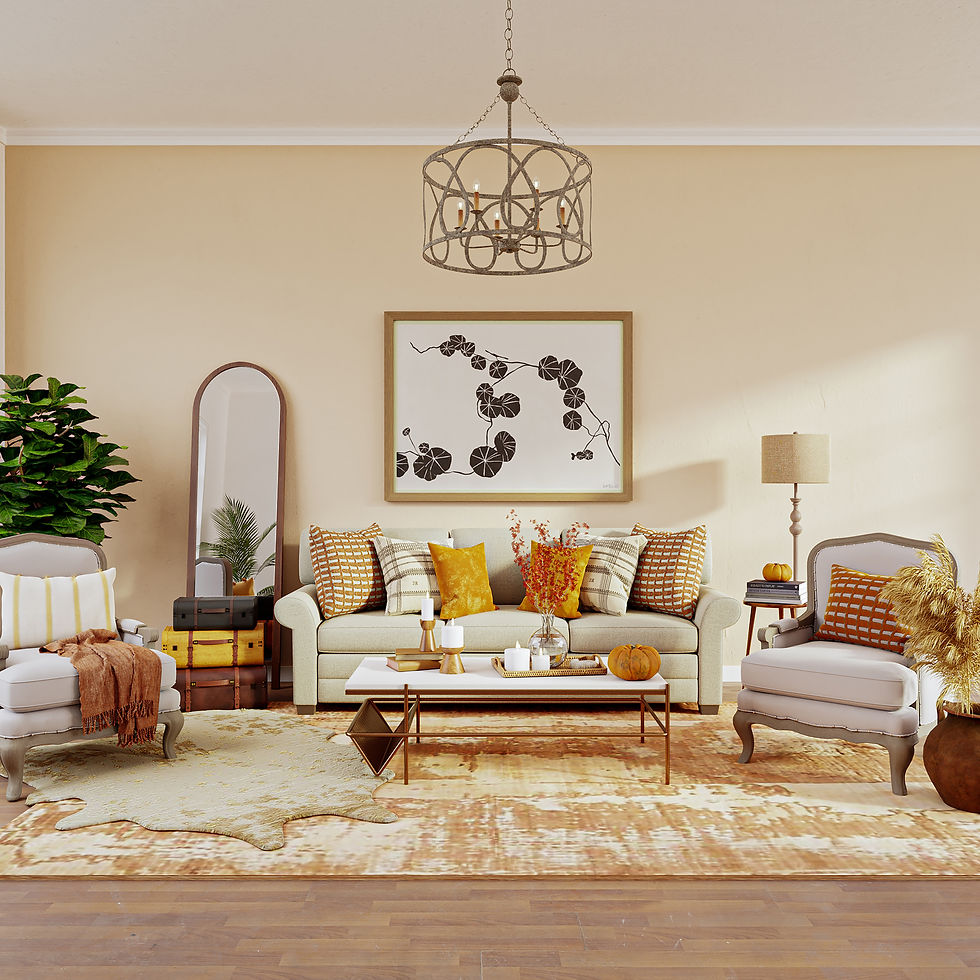10 Interior Designs - Find your style
- www.soulsisterdecorating.com

- Mar 9, 2022
- 4 min read
Updated: Dec 16, 2022
1. Modern
Modern design style stems from decor of the early to mid-20th century and rejects preceding modern design styles which incorporated dramatic elements, heavy textures, and intricate ornamentation. Modern design style favors uncluttered spaces, clean and straight lines, with an overarching theme of functionality in each furnishing and accessory.
Additionally, open-concept floor plans, natural light, and neutral tones dominate a modern interior space. A feeling of simplicity, cleanliness, and openness is the goal with modern design.

2. Traditional
Traditional interior design style is inspired by European that gained popularity in the
18th & 19th century. Elements of this style include: intricate tile and wooden floor patterns, wooden paneling and moldings, elegant furniture and antiques, a neutral palette with rich tones for furniture and accents.
Traditional design creates a calm, tidy space, that contains a sense of elegance and simplicity. In addition, symmetry is an important aspect of traditional interior decor, which further creates this orderly feel. Furnishings and accents should center on a focal point — usually a television, artwork, or fireplace — while furniture and accessories alike are often displayed in pairs.

3. Minimalist
Minimalist interior design is all about simplicity. Elements of minimalist design include clean lines, a concise color palette, quality furnishings, and natural lighting, to create an air of sophistication and ease in your home. Accessories are used sparingly, in a “less is more” tactic, and compliment the simplistic nature of a minimalist style design.
Much like the modern interior design, a minimalist design style will never go out of style.

4. Rustic
Rustic interior design style emphasizes the rugged, natural beauty of a space. The design is simple, organic, and utilizes many raw materials like stone and unfinished wood. Therefore, rustic style rejects many aspects of modern design, such as clean or straight lines, geometric patterns, and bright, catchy accents. Instead, style your rustic space with antiques, leather, and wood, while utilizing warm color palettes.

5. Industrial
Often seen in modern homes, loft apartments, and commercial spaces, industrial style decor is widely regarded. Industrial design expresses neutral tones, wood, brick, and metal materials, and functional but tasteful furnishings.
Open and uncluttered, industrial style incorporates the best of modern and rustic styles by mixing the old with the new. So vintage accessories and factory-like pieces compliment industrial spaces: think distressed items, old photographs, or vintage light fixtures.

6. Farmhouse
A classic farmhouse style is warm, full of character and charm. Pulling from rustic and traditional design, the farmhouse style utilizes natural materials, antiques, and a neutral palette with rich-colored accents. Furnishing and accessories are comfortable and practical, with a mix of vintage furniture.
On the other hand, modern farmhouse design takes the comfortable farmhouse style, and adds modern and industrial touches. Less rustic and more sophisticated, the modern farmhouse adds elements like straight lines, metallic accents, and rich colors.
Shabby chic style is also generally associated with a farmhouse style, usually favoring a softer, more feminine palette of grays, lace, and creams.

7. Coastal
The goal of a coastal interior design style is to create a light, breezy, and beach-like space. Coastal design takes advantage of all natural light and often blends the indoor with surrounding outdoor areas.
Many natural elements are incorporated to create a coastal interior design: furniture made of wicker or rattan, light or weathered woods, and/or natural textiles. Coastal styling lacks metallics or flashy patterns, but rather include natural and homey materials.
A coastal home is all about the color white, with touches of blues and greens. Similarly, furniture and accessories are often wooden, or in light airy colors as well. Accessories in a coastal design vary — seashells, plants, or wicker accessories — it all pulls together to create a homey, beach feel.

8. Mid-century Modern
Evolved from modern design style, this era decor and tones are of the 1940's to the 1960's.
Mid-century modern encompasses a retro, yet fresh feel, with quirky touches, relaxed decor, and bold colors.
Accessories with abstract patterns, prints, and art add character to mid-century modern spaces. Dramatic pieces such as wall hangings, dark accent walls, vases or other decorative finds are welcomed in this style.

9. Eclectic
Similar to a Bohemian style, eclectic interior design is bright, cultural, and artistic. Eclectic designs are rich and relaxing, full of color and pattern. Plant accessorizing creates an earthy vibe that is essential in eclectic design, with distressed pieces adding lots of character.
Eclectic design is the opposite of minimalism, with layers of collections and finds and favorite patterns. Playful visual impact and artistic expression are the defining factors of an eclectically designed space.

10. Scandinavian
The goal of Scandinavian-style interior design style is to evoke a sense of calm within the space, while balancing it with utility. Natural colors for furnishing and accessories are soothing to the eye, but functionality equally important in Scandinavian-style decor.
Balance is key, and along with color, the textures of a space must have the right harmony. Whether you are balancing stone with glass fixtures, or concrete with plants.
Scandinavian-style decor is minimalist, but adds touches of character that make it uniquely its own.




Unlock the thrill with world777 by using your unique world777 ID and secure world777 login. Once logged in, your world777 becomes your entry into a world of high-energy casino games and live sports betting. Completing your world777 login means you’re ready to explore immersive gaming, instant withdrawals and sharp odds. With your world777 ID verified and your world777 login secured, you’re equipped to dive into fast-paced action, solid rewards and seamless transactions on the go. Join now, use your world777 login and watch your world777 ID take you into the next level of gaming excitement.
Team world777
https://world777.net.in/
responsible intimacy focuses on consent, communication, and preparation. learning about hygiene and emotional readiness reduces stress and discomfort. partners should always feel heard and respected. we include in the middle pune sex toys simply to raise awareness about safe tools and practices, encouraging thoughtful exploration, privacy, and relationship growth through open dialogue, trust, and mutual comfort for long-term satisfaction.
Found exactly what I was looking for. Thank you! Please write an article about Stem Cell Treatment For Shoulder Pain.
discover the ultimate collection of chandigarh sex toys crafted for maximum enjoyment. with innovative designs and high-quality materials, these products elevate your intimate moments. whether you're exploring solo or with a partner, these toys offer fun, excitement, and satisfaction. discreet delivery ensures your privacy while bringing pleasure to your fingertips.
If you are looking for fast publication journals that are also listed in the ABCD Index, here's how you can approach it and a few key journals to consider:
Visit the ABCD Index Website: Go to https://abcdindex.com
Use the Search or Categories Feature:
Look for journals based on your discipline (Engineering, Management, Tourism, etc.).
Use filters like "Fast Publication" or sort by "Processing Time" if available.
Check for Fast Review and Publication Timeframes:
ABCD Index often lists information about submission to acceptance time and acceptance to publication time.
Check Journal Websites Directly: Once you find a journal on ABCD Index, visit the official website of that journal to verify:
Publication frequency (monthly, bi-monthly, etc.)
Submission and acceptance duration
Article Processing Charges (APC), if any
Scope and indexing